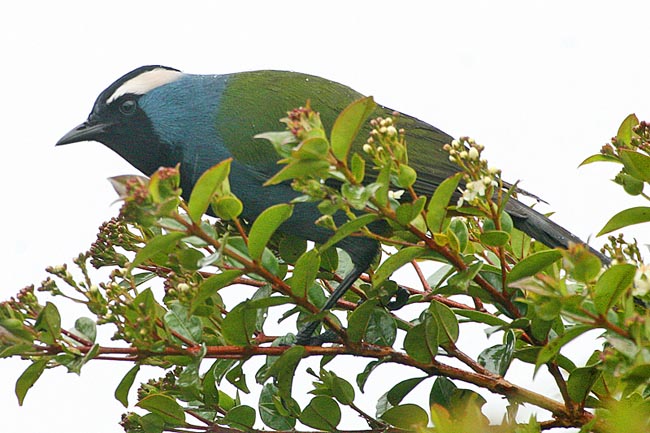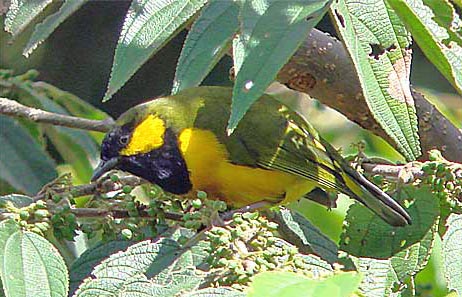
a web page by Don Roberson |
PAINTED BERRYPECKERS Paramythiidae |
||
|
||
The other family member is Tit Berrypecker [below, photos of males by Simon Woolley (left) and Nik Borrow (right)]. The sexes are quite different. The male is brightly patterned like a Day-Glo chickadee while the female is relatively obscure, but both sexes have diagnostic yellow-spotted tertials. |
||
|
||
Crested
Berrypecker is found in high mountain forests only — from the upper
montane zone (above 2500m = above 8000 ft.) to timberline in the
Central Range of New Guinea and on the Huon Peninsula. My encounter
with this elegant bird was high in the Snow Mountains above the Baliem
Valley. Crested Berrypeckers forage in pairs or small parties for
fruit, and sometimes come to ground after seeds or berries. Beehler et
al. write that it "has a bizarre habit of plucking certain large
ericaceous flowers and rubbing its plumage with the crushed corollas."
It gives a faint kissing-like sound. Although it feeds mostly on fruit,
swallowed whole, it also partakes of insects. Coates (1990) tells of
one "observed to pull open a spider cocoon and devour the contents."
The nest is an untidy cup-shaped structure; only the female incubates.
A fine photo of a nest is in Coates (1990). When Crested Berrypecker
was first described to science, it was referred to the starling family
(Sturnidae), and latter placed in it own family next to the oxpeckers
(Buphagidae). Its true evolutionary history was not sorted out until
the advent of molecular taxonomy (Coates 2008). Tit Berrypecker is a gregarious, small, chunky bird of mountain forests. These birds range in small parties in thick forests, mostly between 1400-3000m (4500 to 10,000 ft). They can be common within the preferred altitudinal zone. Although they, too, mostly feed on berries and fruits, they also probe flower blossoms. Rather little is known of breeding behavior, although they are said to have an open cup of moss (Coates 1990). The typical vocalization recalls Cedar Waxwing. Males often reminded European observers of Great Tit. For a long time, the Painted Berrypeckers were included with typical berrypeckers among the Flowerpeckers [Dicaeidae; e.g., Beehler et al. 1986]. Sibley & Ahlquist (1990) elevated these two species in two distinctive genera to their own family, the Paramythiidae. This was based on DNA-DNA hybridization studies that showed they were related to each other but rather far removed from flowerpeckers. It is now clear this small family is an offshoot among the Corvoid assemblage (e.g., Barker et al. 2004), but their exact relationship to other corvoid clades is still not entirely clear. Various lists of 'families of the world' place them in different sequences within the larger assemblage. |
||
Photos: Simon Woolley photographed the Crested Berrypecker Paramythia montium on Mt. Hagen, Papua New Guinea, in July 2008. The Tit Berrypecker Oreocharis arfaki was photographed at Tari, Papua New Guinea, by Simon Woolley in July 2008, and by Nik Borrow in 2008. Bibliographic note: There is no "family book" covering the Paramythiidae, but good photographs and information about both species are in Coates (1990, 2008). Literature cited:
|
 The
Paramythiidae is a family of just two species in two genera which are
endemic to New Guinea. Both are brightly colored berry-eating birds of
the New Guinea highlands, mostly working the canopy in thick forests. Crested Berrypecker
(left, shown here in a nice photo of a male by Simon Woolley) is a
medium-sized bird of striking color pattern (as shown in the photo)
that has an erectable crest (not shown). The sexes are similar.
The
Paramythiidae is a family of just two species in two genera which are
endemic to New Guinea. Both are brightly colored berry-eating birds of
the New Guinea highlands, mostly working the canopy in thick forests. Crested Berrypecker
(left, shown here in a nice photo of a male by Simon Woolley) is a
medium-sized bird of striking color pattern (as shown in the photo)
that has an erectable crest (not shown). The sexes are similar.
